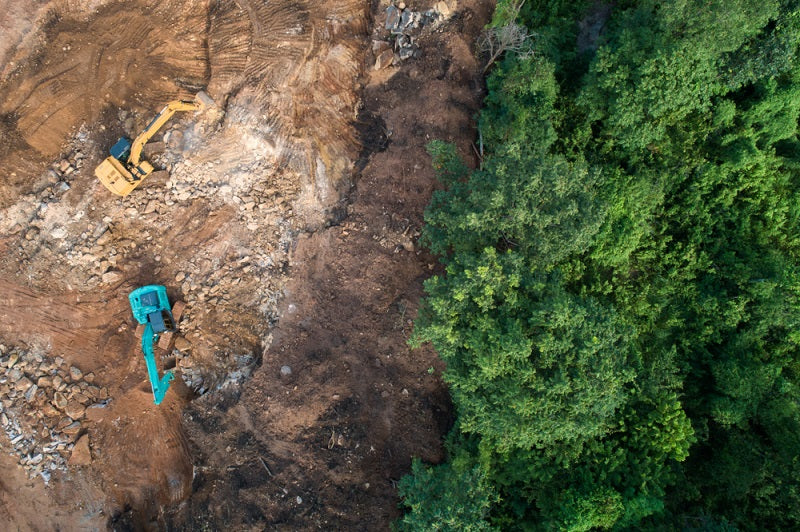
TLDR
Did you know that nearly 15 billion trees are cut down each year?1 Because of this, you may be wondering, how does deforestation affect the environment? Deforestation continues to threaten the earth’s natural ecosystem, fuel climate change, and negatively affect our overall well-being. The time for change has never been more upon us.
But when it comes to how to stop deforestation, individuals can often feel overwhelmed by the insurmountable challenge ahead. Thankfully, it’s often the small changes—when adopted by the collective—that can drive the biggest impacts.
From using recycled and bamboo paper products, planting trees, to reducing your carbon footprint, we’re here to shine a light on four easy ways you can help with forest restoration.
#1 Reduce Your Carbon Footprint
Before we continue, do you know exactly what a carbon footprint entails?
Essentially, a carbon footprint is the amount of carbon dioxide released into the atmosphere by a given entity (it’s a measurement). When calculating the carbon footprint of an individual or organization, factors like travel, manufacturing, consumer purchases, and waste are weighed into the formula.
For instance, the United States has one of the highest carbon footprints in the world, with the average person using approximately 16 tons.2 The average—globally—is about 25% of ours.
To that end, a simple tool you can use to visualize how your actions contribute greenhouse gas emissions to the atmosphere is the EPA’s carbon footprint calculator.
Our goal, of course, is to reduce the carbon footprint incrementally by adopting numerous lifestyle changes like recycling, making conscious dietary decisions, and spending money with organizations committed to halting deforestation.
Reduce, Reuse, Recycle
In your everyday life, there are small steps you can take that can make a big impact in reducing your carbon footprint. Reducing, reusing, and recycling material is one of the most influential.
To that end, consider:
- Using tree-free items like 100% recycled paper towels for single-use paper products
- Recycling household items and packaging like paper, plastic, and glass
- Opting for toilet paper alternatives
- Composting food waste or using a compost pick-up service
- Opting for bikes, ride shares, and public transportation (instead of driving)
- Choosing reusable containers like grocery bags, mason jars, and beeswax food covers
Recycling, reusing, and reducing helps omit the need to replenish raw materials, lessening the demand for products that are sourced from natural resources found in a tropical forest.
Adjust the Way You Eat
The global food chain is massive, nuanced, and highly complex. In which case, tracking ethical sourcing and production along every rivet of the chain can prove difficult. In terms of reducing your carbon footprint, however, there are four primary crops driving forest destruction:3
-
Palm Oil – If you look closely at the ingredients of common food and beauty products, you’ll notice that a large number of them contain palm oil. The demand for palm oil, unfortunately, has resulted in massive forest loss. In Indonesia alone, the palm oil industry is responsible for destroying 90% of their orangutan habitat. To reduce demand and forest destruction, try alternative oils—like avocado or olive—and prepackaged foods sans palm oil.
- Cocoa – Despite chocolate’s delicious flavor, the fact that cocoa’s high demand has led to a devastating 50% biodiversity loss in Madagascar and Papua New Guinea can leave a bitter taste in your mouth. Instead of cutting yourself off from cocoa, however, look for producers that pledge to source from farmers using sustainable practices.
- Coffee – From starting the day with a cup of joe to a midday mochaccino and an after-dinner espresso, coffee is beloved in our current culture. Our coffee enthusiasm has resulted in 11 million hectares devoted to production globally. In which case, it’s paramount that you try to purchase coffee from sources that pledge a commitment to tropical forest restoration.
- Meat – Forests are razed to make room for grazing pastures and growing crops that feed livestock. Additionally, compared to other livestock, grazing cows are known to contribute the highest amount of greenhouse gas emissions. Lowering red meat consumption can help adjust the supply and demand curve, especially if you begin to default to plant-based products.

Spend with Conscious Organizations
A practical (and simple) way to help lower the deforestation rate is by purchasing products from businesses that are committed to protecting natural resources. Supporting entities that make environmentally ethical business choices is also the best way to encourage other businesses to adopt similar practices.
Should this sound like an avenue you want to take, consider looking for companies that:
- Pledge to remove deforestation from their supply chain
- Minimize their use of plastic packaging
- Recycle paper products
- Uphold paper-free offices
- Choose sustainable development practices
- Don’t use palm oil in their food, health, and beauty products
If you’re wondering how to stop deforestation in the Amazon and other forests, reducing demand around the products sourced from them can be instrumental in the process.
#2 Encourage Political Change
Showcase your support for sustainable, tree-friendly policies by writing to your government representatives and voting for meaningful change. For instance, designating a forest as a national park or preserve is a decision governing officials can make to prevent habitat and forest loss.
However, that decision starts with you and your voice.
A recent study, conducted by the University of Michigan, proved that naming lands as “protected” reduced the deforestation rate in the Amazon. Additionally, the study found that regions completely prohibiting disturbance were better at preventing deforestation than regions that allowed for controlled resource extraction. 4
#3 Let’s Get Active!
Does the boots on the ground approach complement your personality and resolve? Fantastic. Environmental organizations are always looking for volunteers to help forward their cause.
Whether helping with administrative duties on a campaign or trying to communicate with policymakers, there are myriad ways to get involved.
If you’re unsure where to start, here are a few organizations we love that are actively committed to halting deforestation:
Volunteers are often a vital part of a nonprofit’s operations. Consider sharing your expertise and enthusiasm to help support the forest-friendly organization you believe in.

#4 Reforestation
While each year results in a hefty loss of our natural forests, one of the most practical ways to counteract the effects of deforestation is to take steps to re-green the planet. Mother Nature is resilient. With a little help from us, land that was once devastated has the potential to thrive again.
Plant A Tree
You don’t need to devote your life to reforesting an entire island like Jadav Payeng, “The Forest Man of India,'' who turned a barren, sun-scorched sand bar into a thriving ecosystem by planting trees for more than forty years.5
Instead, you can start wherever you’re most comfortable. For instance, you can make an annual family event of planting a tree in honor of a loved one, or join in on the last Friday of April each year to plant a tree in celebration of Arbor Day.
If the work intimidates you, there are plenty of organizations—like One Tree Planted—that will plant trees in areas of land that need it the most.
Use Native Plants in Landscaping
As habitats are diminished, the animals that lived there start to migrate and search for other sources of food. Consider swapping out a grass lawn with a native plant garden that will provide resources for a variety of species.
Add plants to your yard that provide crucial support for migrating species, like the newly-endangered monarch butterfly, who passes through much of North America before overwintering in the forests and mountains of Mexico.6
Additionally, there are many local organizations committed to teaching the importance of native plant species, and they often give away native trees that can be planted on your property or in your local communities.
Guerilla Gardening
Guerrilla gardening is a movement centered around cultivating neglected public lots—in urban areas—and turning them into thriving micro-gardens. Urbanization often neglects the natural landscape, clearing it for bigger buildings, wider roads, and an influx of people.
City dwellers know that there are always neighborhood eyesores that are overgrown and forgotten. Guerilla gardeners travel to these abandoned areas and plant trees, produce, and flowers to provide sustainable resources for the local communities.
Help Stop Deforestation With Reel Paper
Trees are the earth’s lifeblood, connecting us through the air we breathe, the roots in the soil, and the biologically diverse nature that surrounds us. By helping stop deforestation, you’re actively combating climate change, extinction, and the displacement of native communities.
At Reel Paper, our commitment to preserving our forests takes the form of innovative, tree-free products. When it comes to product selection (and demand reduction), consider using our bamboo toilet paper or recycled paper towels, which are made through sustainable practices and come in plastic-free packaging. You might even consider buying bulk toilet paper for an environmentally-friendly option to stock your bathroom.
We believe that small changes drive massive impacts. By doing any (or all) of what we’ve listed above, you should breathe proudly knowing you’re contributing to a greener, healthier future.
Sources:
- Nature. Global forest survey finds trillions of trees. https://www.nature.com/articles/nature.2015.18287
- The Nature Conservancy. Calculate Your Carbon Footprint. https://www.nature.org/en-us/get-involved/how-to-help/carbon-footprint-calculator/
- One Green Planet. 4 Foods That Are Eating the World’s Forests And How to Choose Better. https://www.onegreenplanet.org/environment/foods-that-are-eating-the-worlds-forests-and-how-to-choose-better/
- University of Michigan News. Protected areas successfully prevent deforestation in Amazon rainforest. https://news.umich.edu/protected-areas-successfully-prevent-deforestation-in-amazon-rainforest/
- NPR. A Lifetime Of Planting Trees On A Remote River Island: Meet India's Forest Man. https://www.npr.org/sections/parallels/2017/12/26/572421590/hed-take-his-own-life-before-killing-a-tree-meet-india-s-forest-man
- The Washington Post. Why monarch butterflies, now endangered, are on the ‘edge of collapse’. https://www.washingtonpost.com/climate-environment/2022/07/21/monarch-butterfly-endangered-iucn/
- ABC. Guerrilla gardeners spent pandemic turning abandoned spaces into thriving community gardens. https://www.abc.net.au/everyday/how-to-start-a-guerilla-garden/101239240
- Center for Sustainable Systems, University of Michigan. Carbon Footprint Factsheet. https://css.umich.edu/publications/factsheets/sustainability-indicators/carbon-footprint-factsheet
- The New York Times. Hundreds of Companies Promised to Help Save Forests. Did They? https://www.nytimes.com/2021/12/02/climate/companies-net-zero-deforestation.html




0 comments